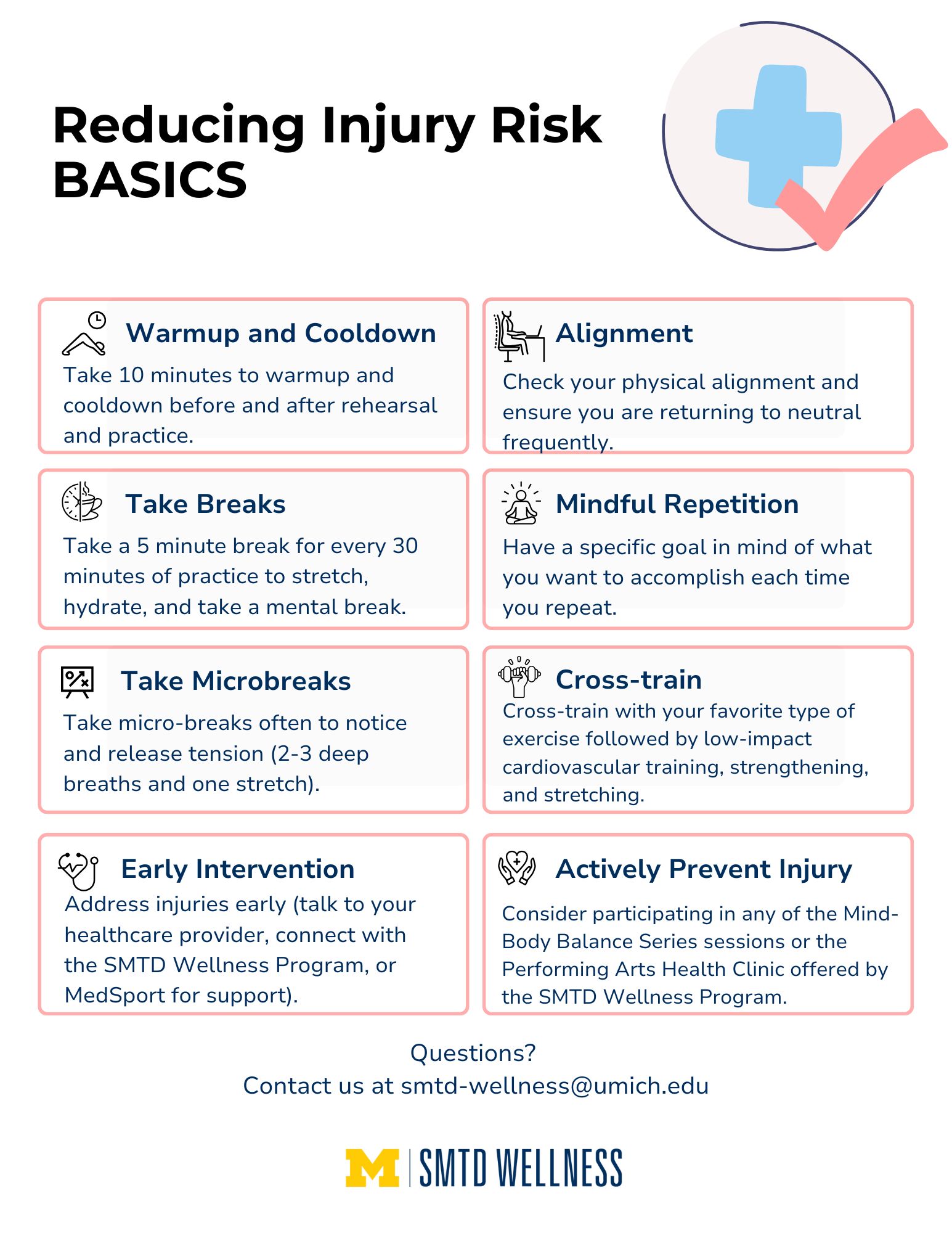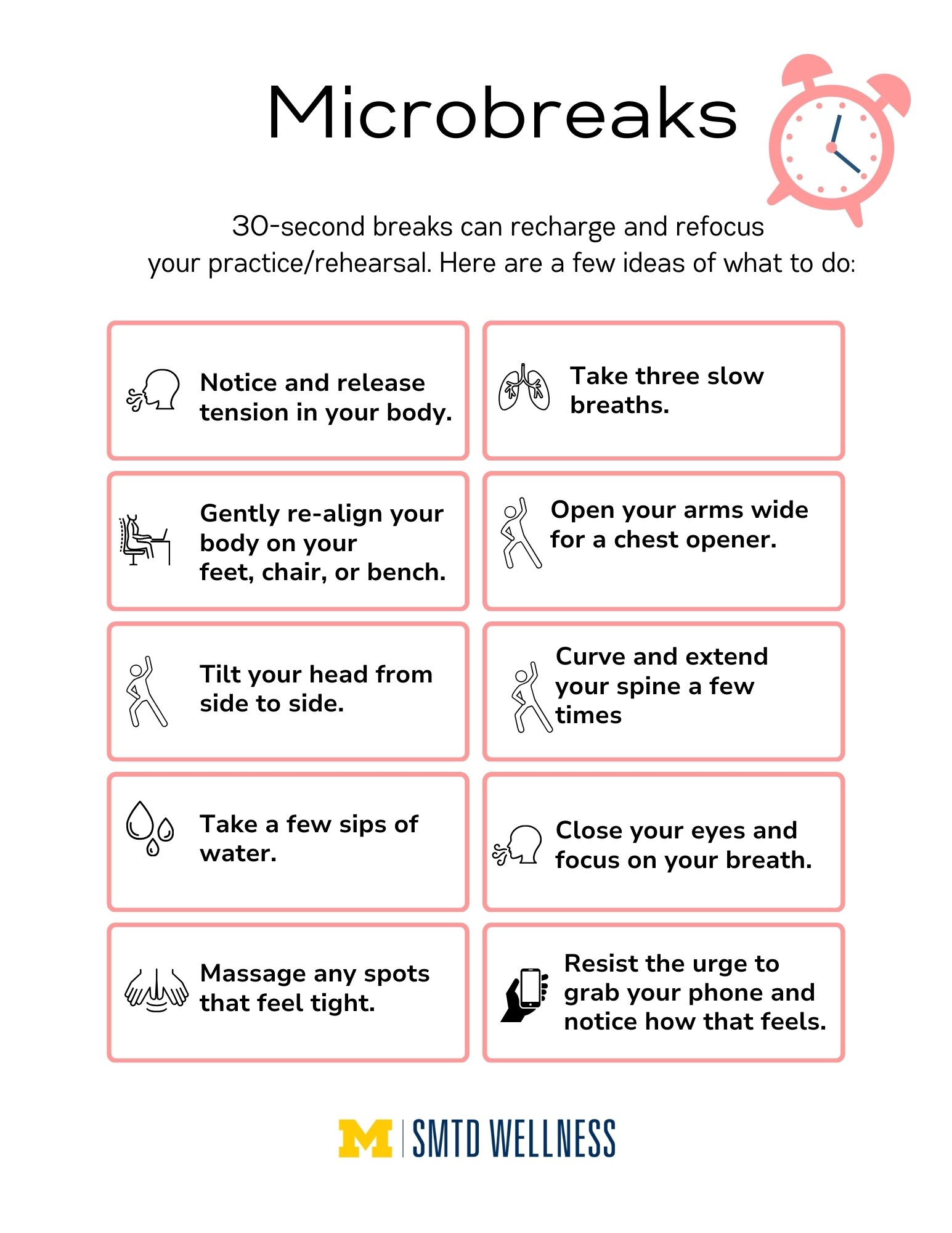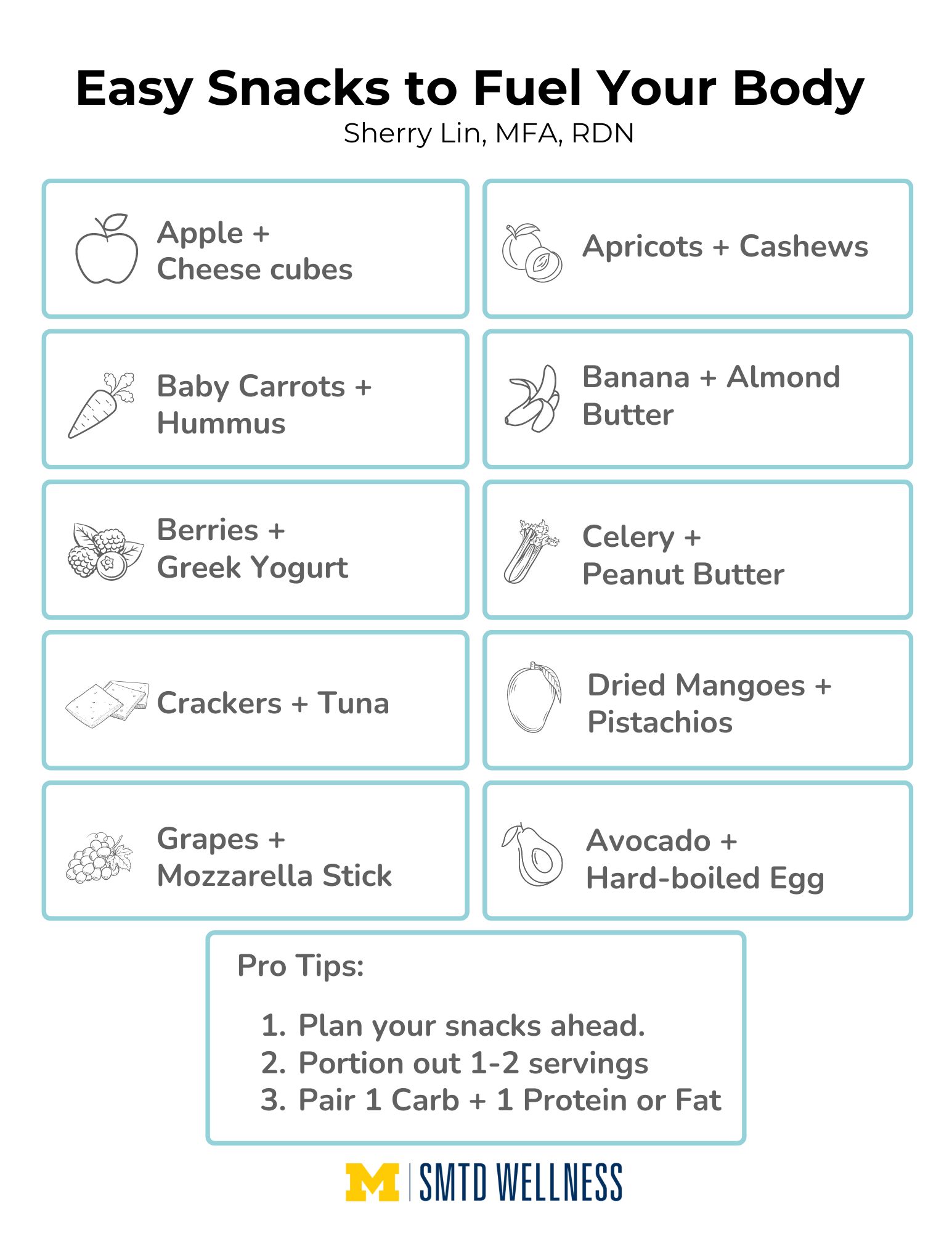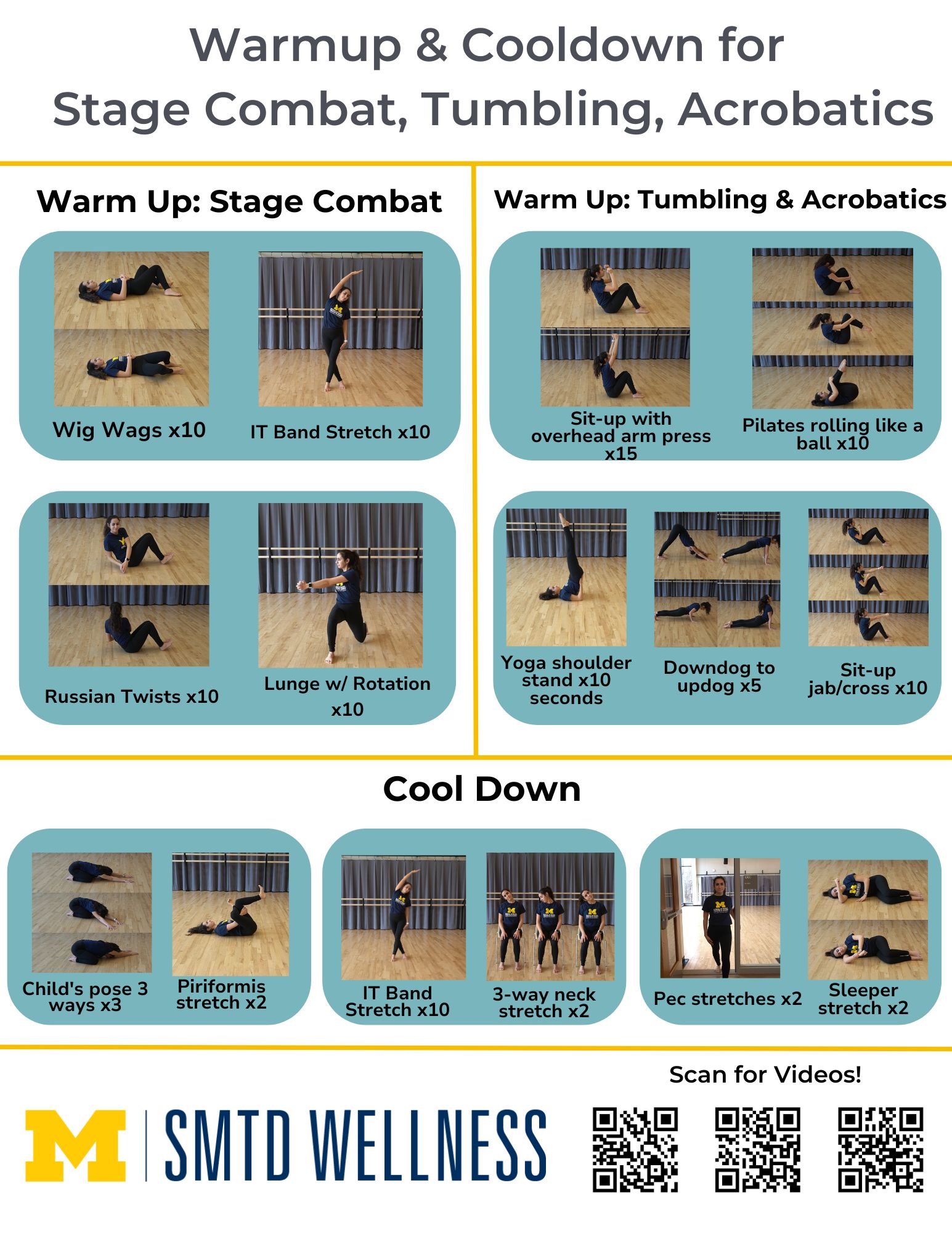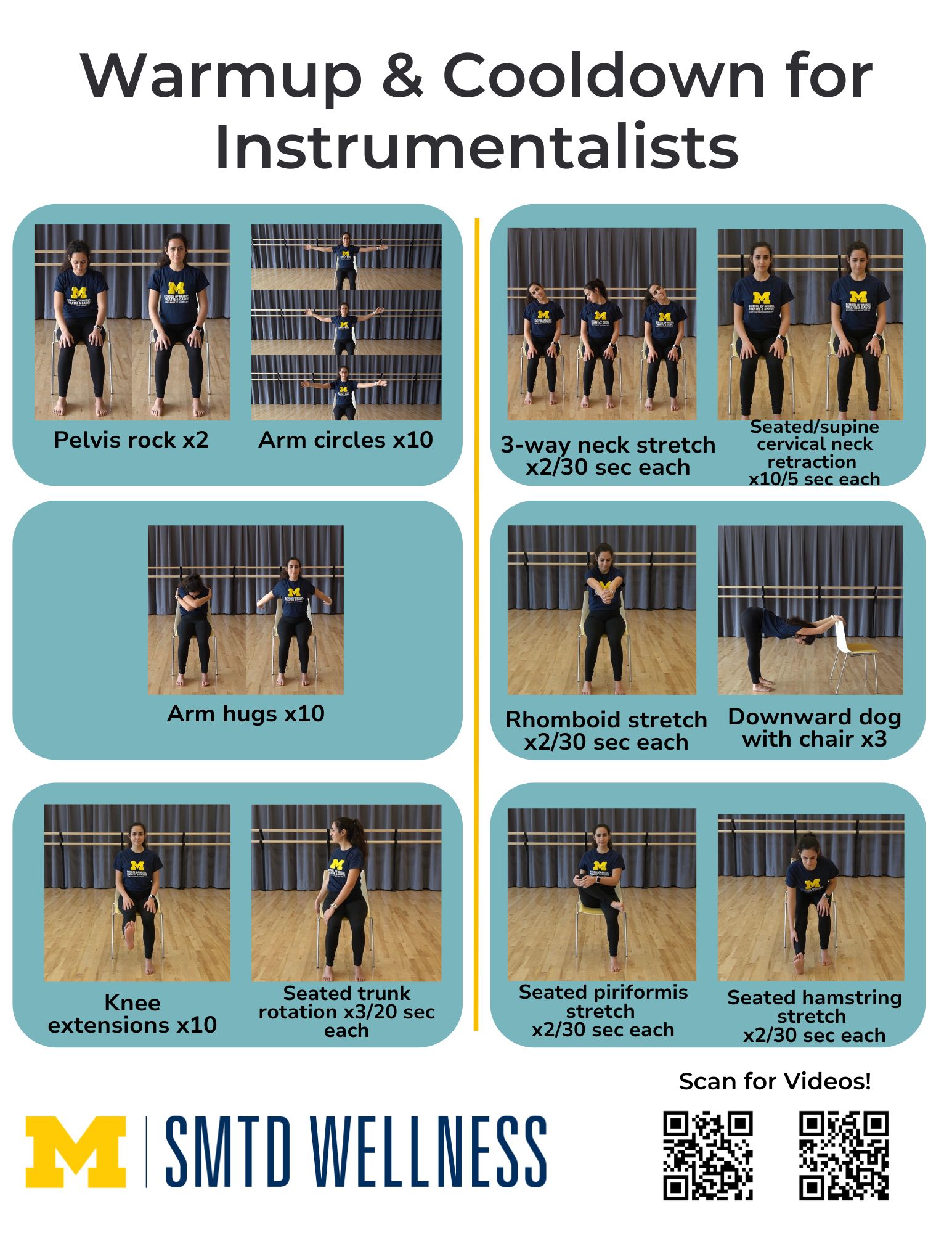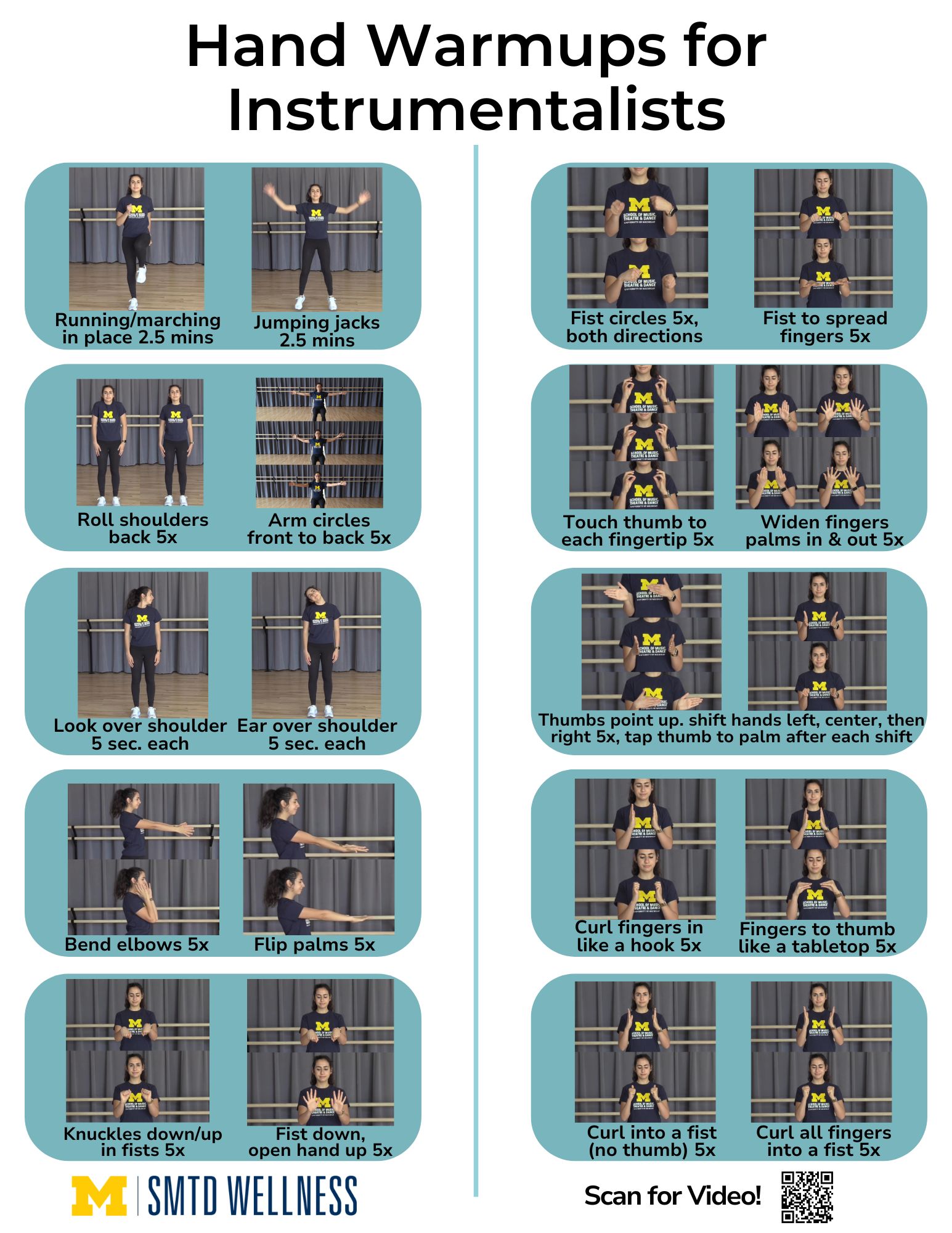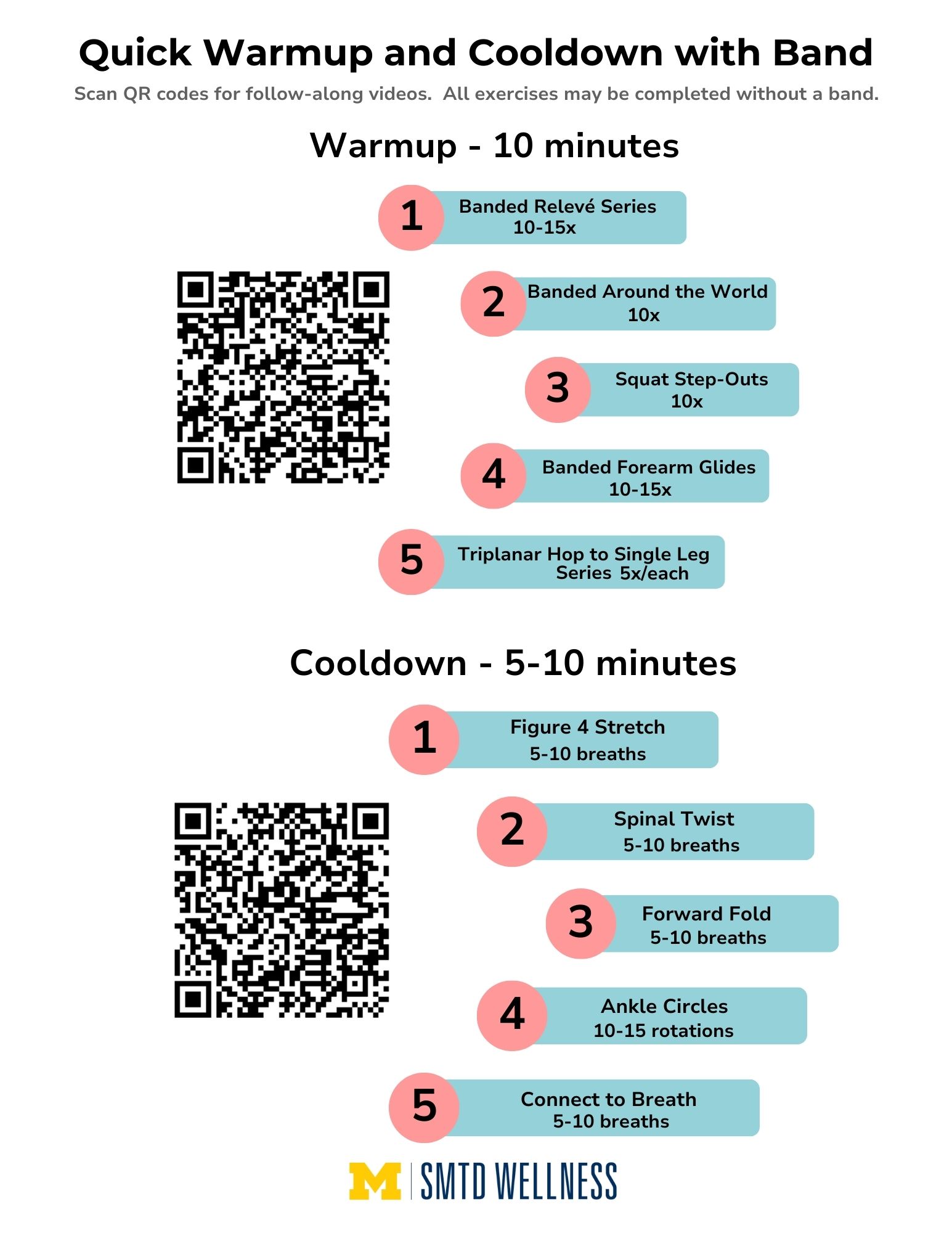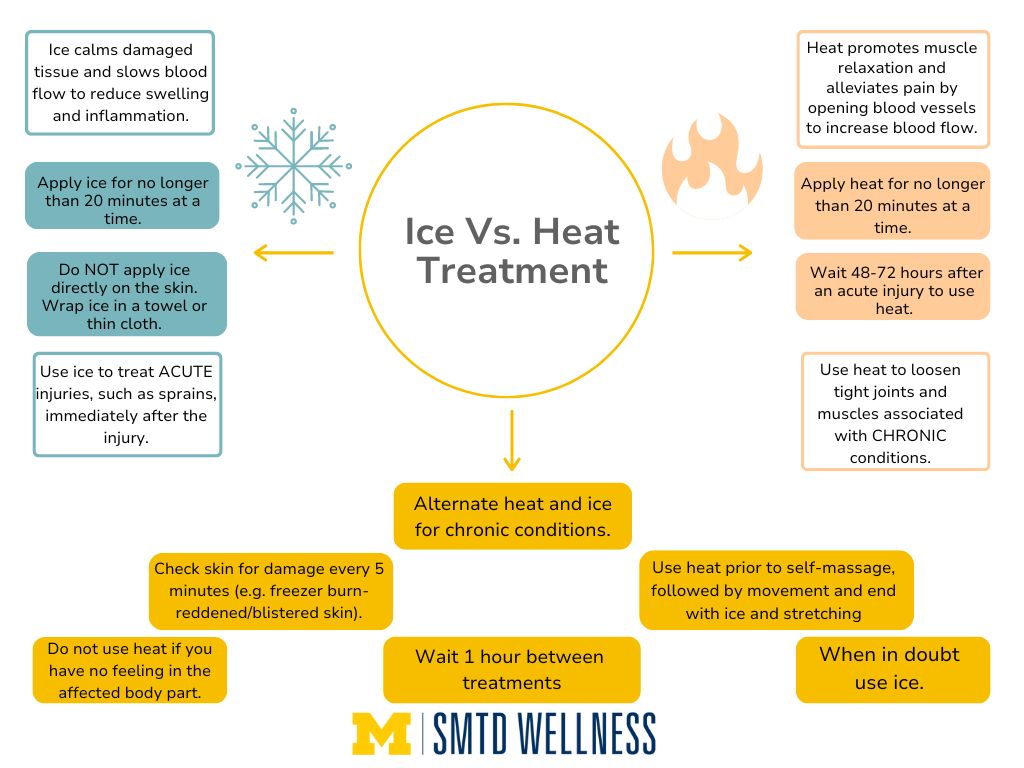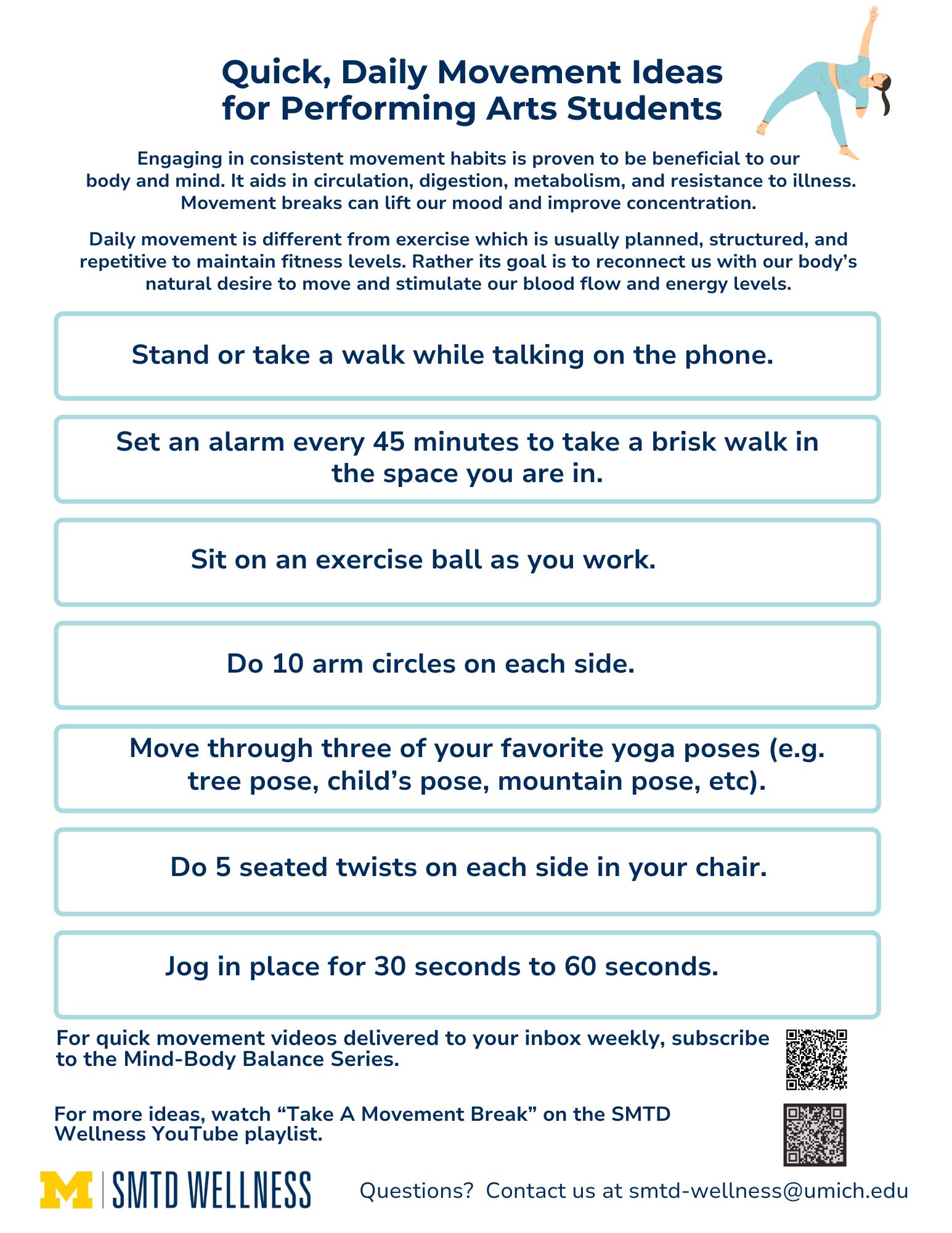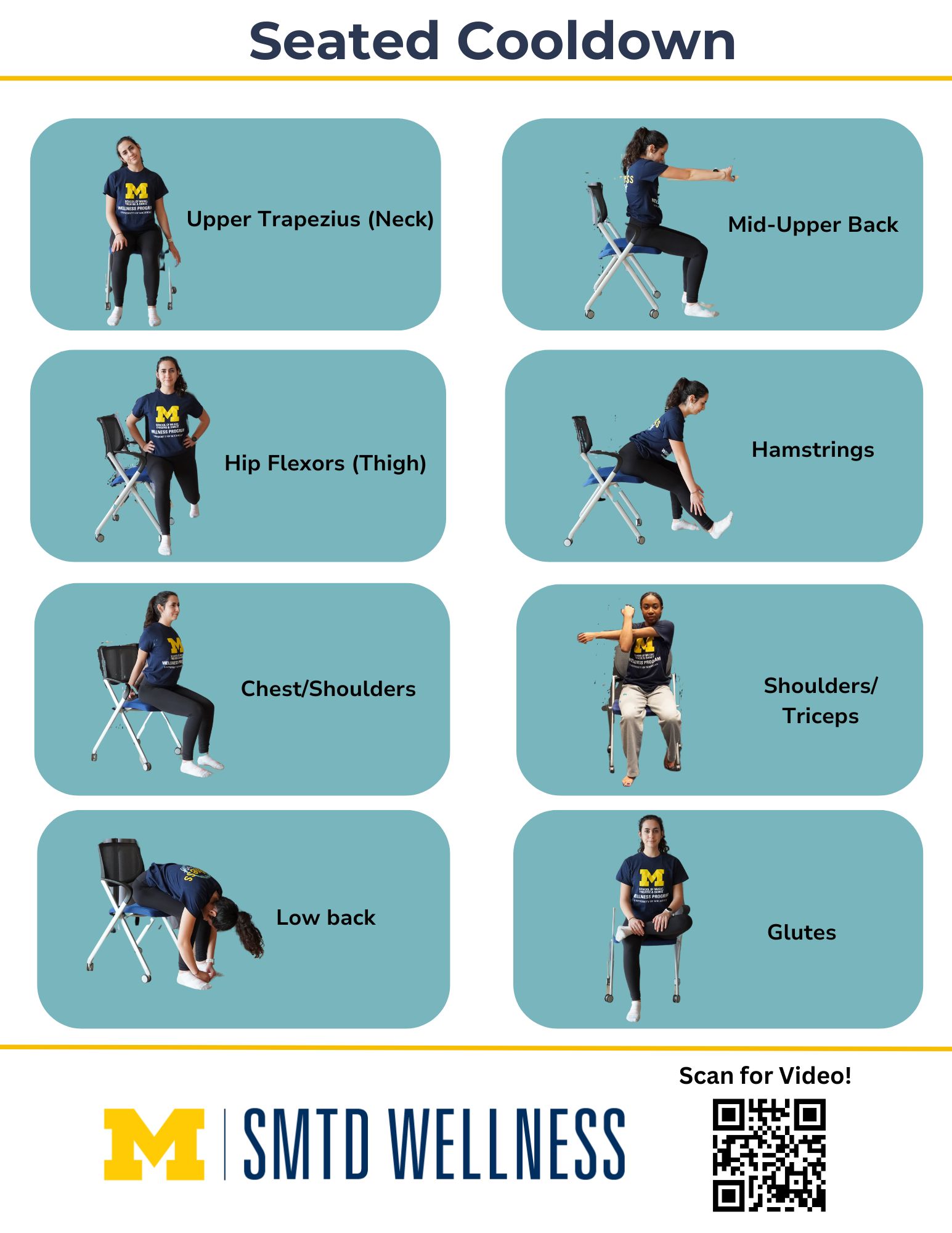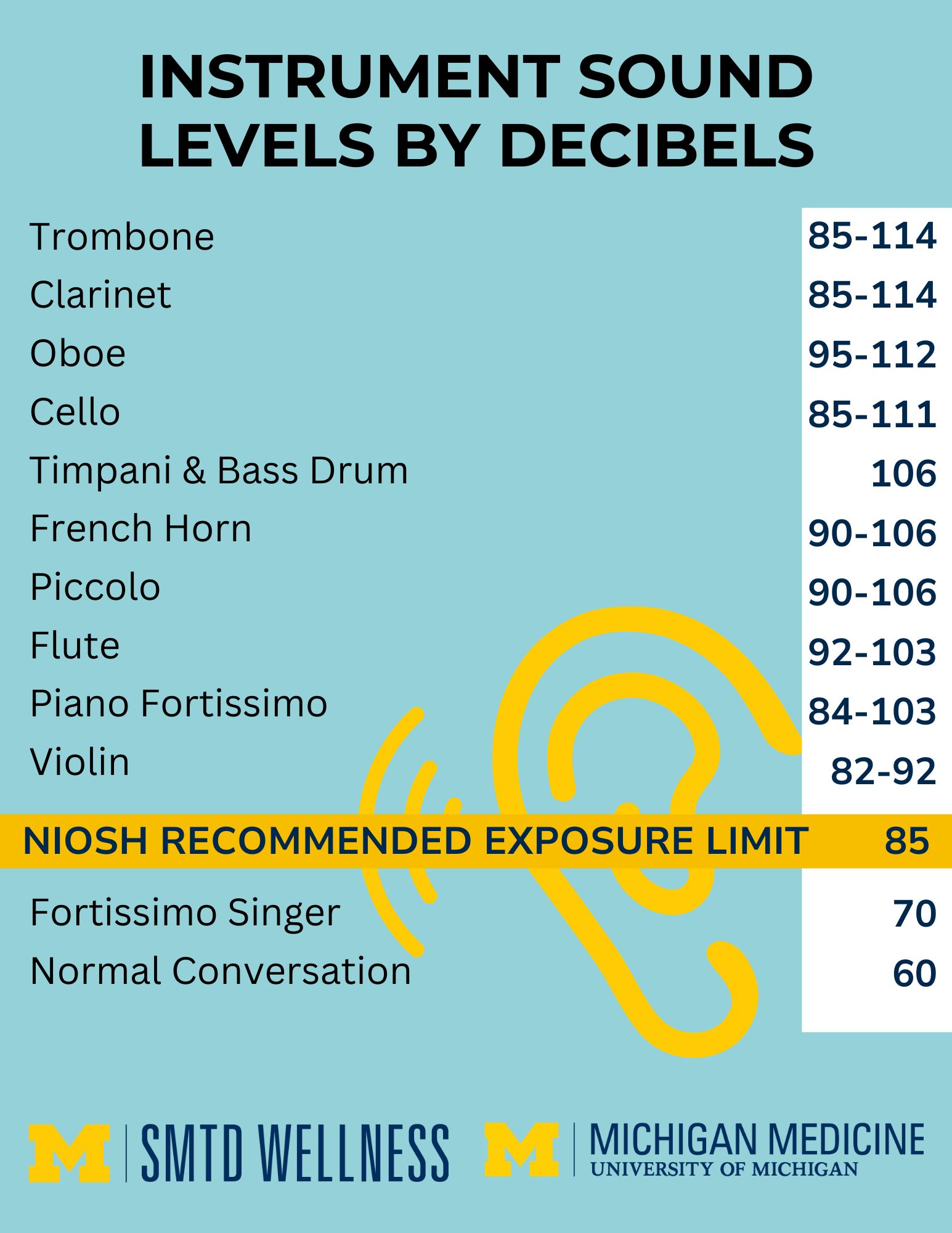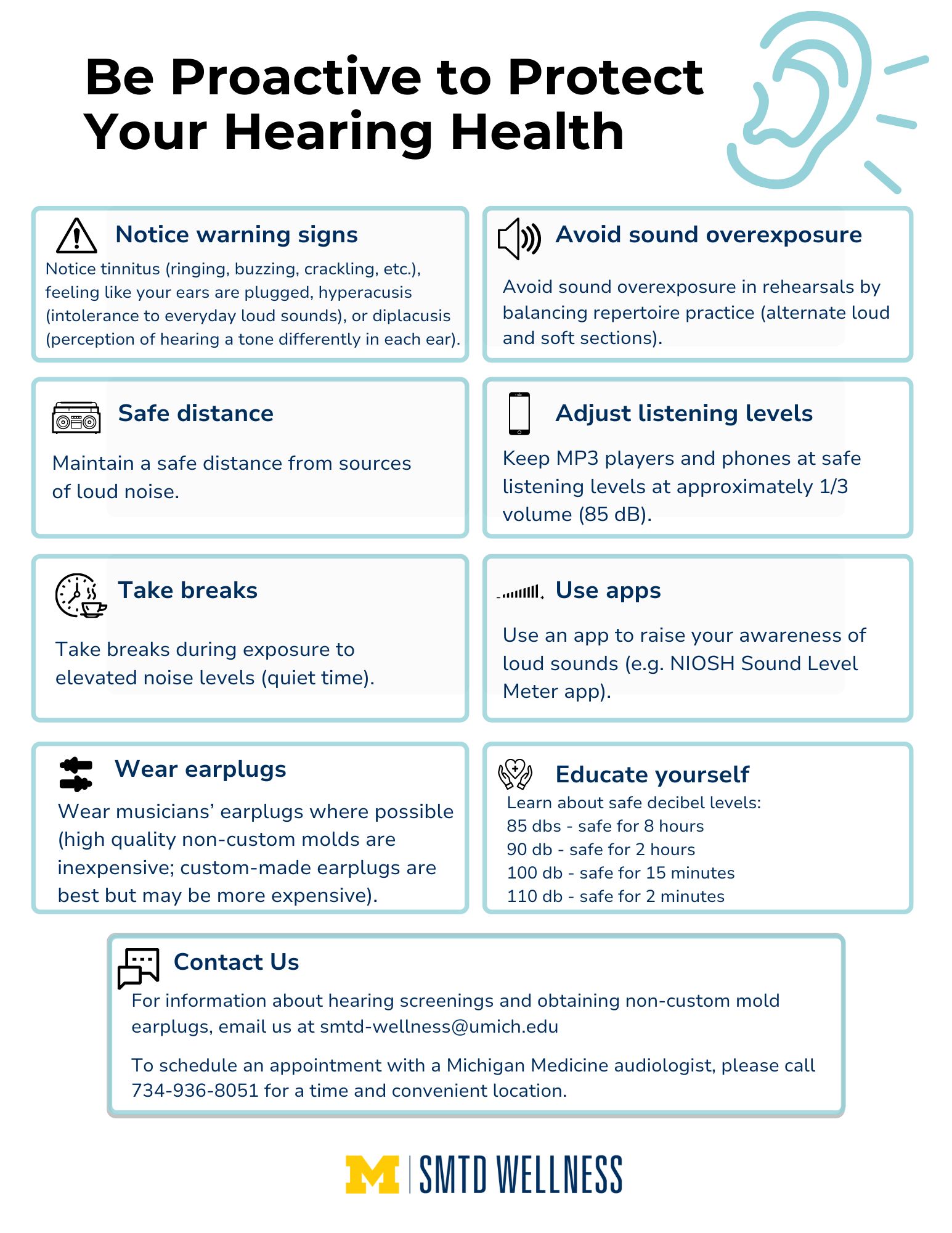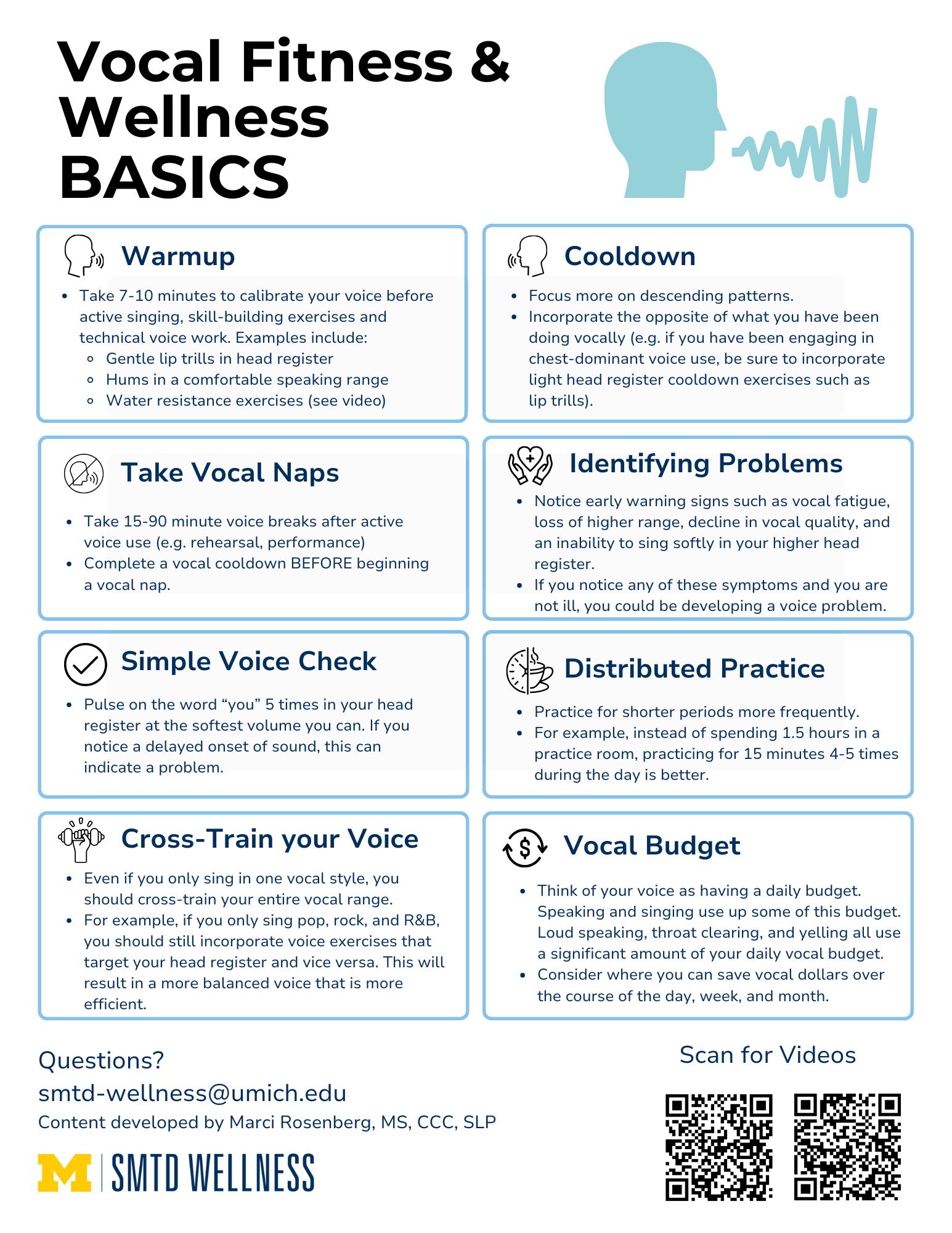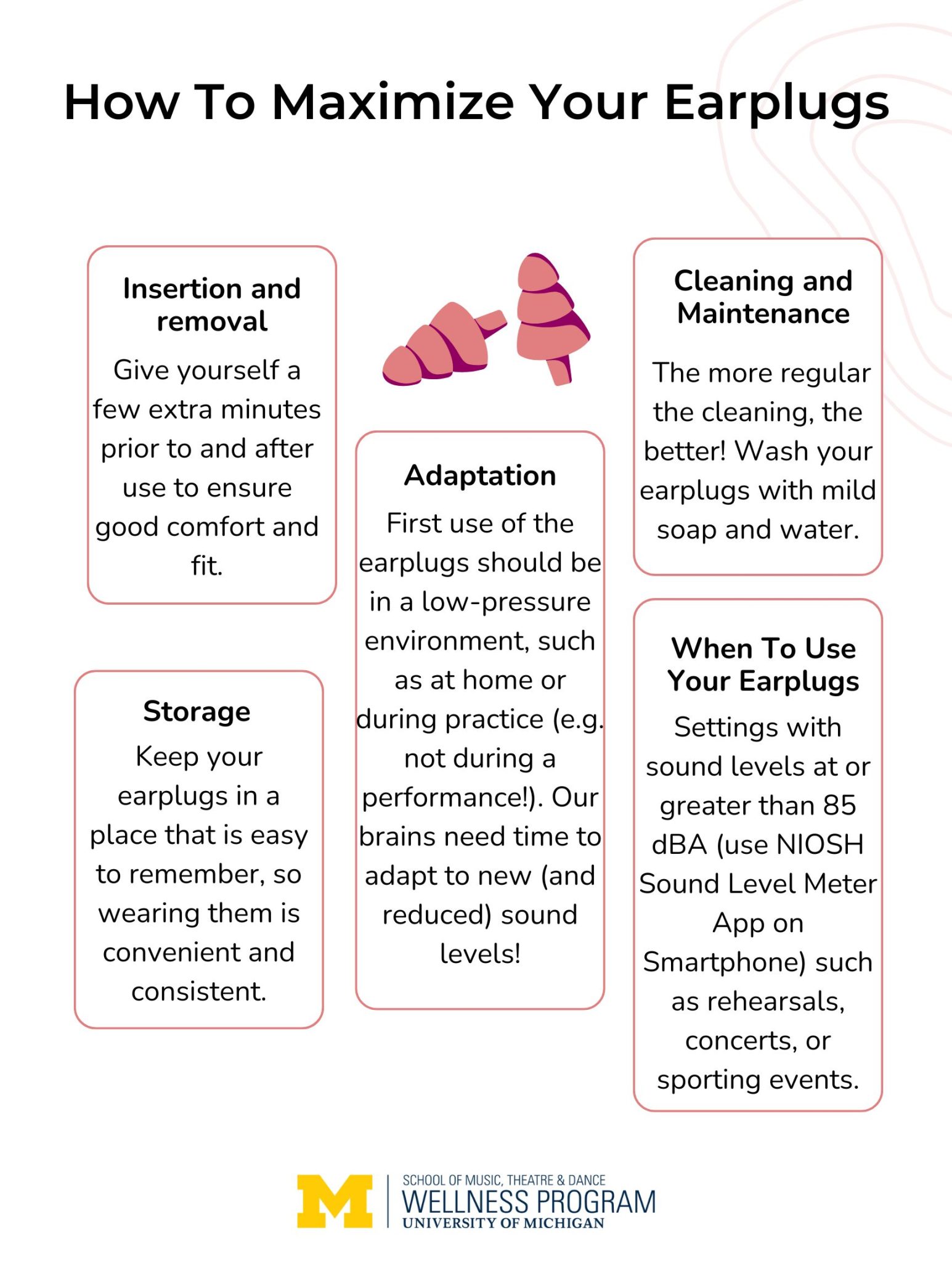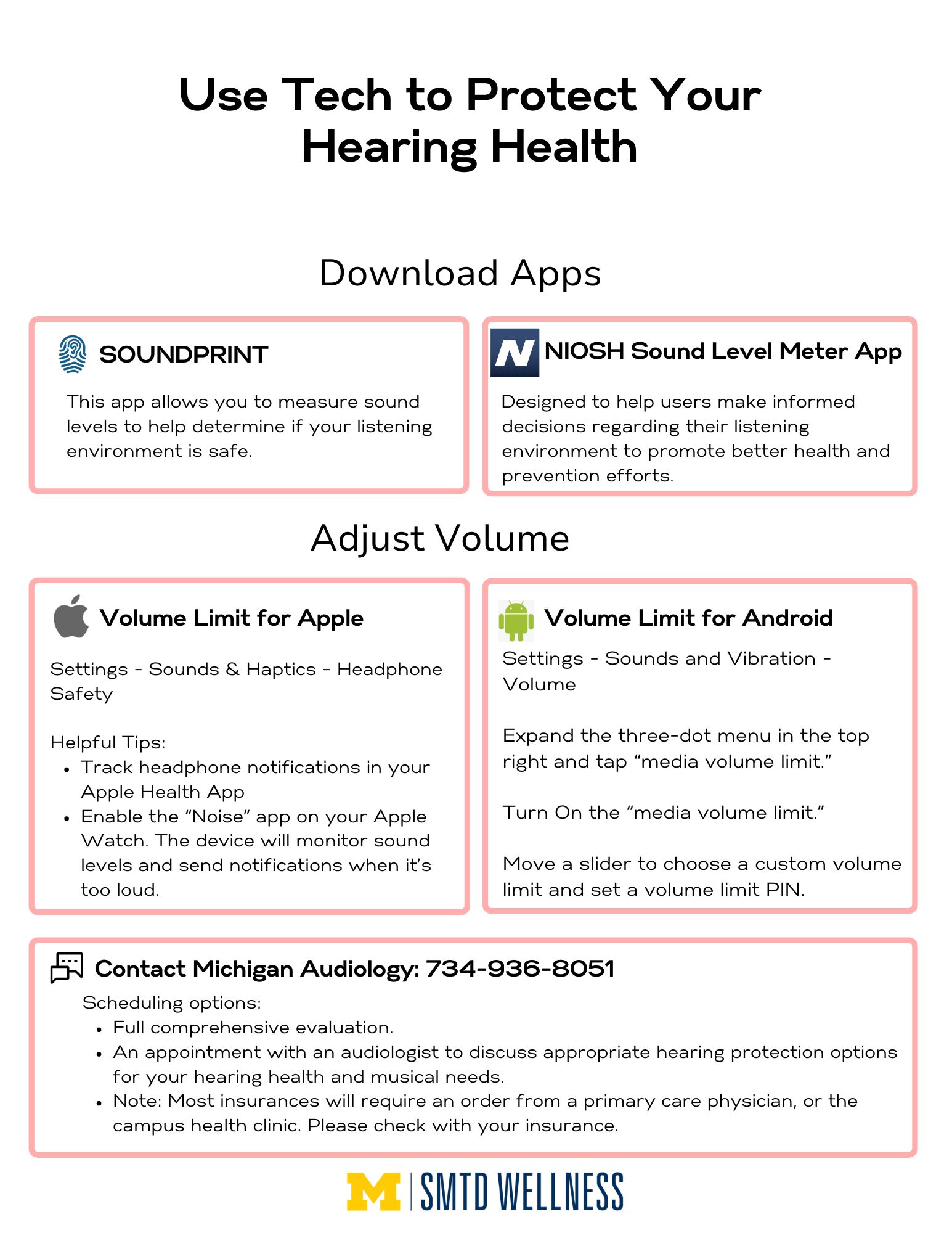Wellness Guides
The Wellness Program has created a variety of infographics and toolkits to help you with accessing information and resources quickly and effectively.
Physical Health Infographics
Reducing Injury Risk BASICS
- Warmup and Cooldown: Take 10 minutes to warmup and cooldown before and after rehearsal and practice.
- Alignment: Check your physical alignment and ensure you are returning to neutral frequently.
- Take Breaks: Take a 5 minute break for every 30 minutes of practice to stretch, hydrate, and take a mental break.
- Mindful Repetition: Have a specific goal in mind of what you want to accomplish each time you repeat.
- Take Microbreaks: Take micro-breaks often to notice and release tension (2-3 deep breaths and one stretch).
- Cross-train: Cross-train with your favorite type of exercise followed by low-impact cardiovascular training, strengthening, and stretching.
- Early Intervention: Address injuries early (talk to your healthcare provider, connect with the SMTD Wellness Program, or MedSport for support).
- Actively prevent injury: Consider participating in any of the Mind-Body Balance Series sessions or the Performing Arts Health Clinic offered by the SMTD Wellness Program.
Questions? Contact us at [email protected]
Take a Microbreak
30-second breaks can recharge and refocus your practice/rehearsal. Here are a few ideas of what to do:
- Notice and release tension in your body.
- Take three slow breaths.
- Gently re-align your body on your feet, chair, or bench.
- Open your arms wide for a chest opener.
- Tilt your head from side to side.
- Curve and extend your spine a few times.
- Take a few sips of water
- Close your eyes and focus on your breath.
- Massage any spots that feel tight.
- Resist the urge to check news or social media and notice how that feels.
Easy Snacks to Fuel Your Body & Brain
Sherry Lin, MFA, RDN
- Apple + Cheese Cubes
- Apricots + Cashews
- Baby Carrots + Hummus
- Banana + Almond Butter
- Berries + Greek Yogurt
- Celery + Peanut Butter
- Crackers + Tuna
- Dried Mangoes + Pistachios
- Grapes + Mozzarella Stick
- Avocado + Hard-boiled egg
Pro Tips:
- Plan your snacks ahead
- Portion out 1-2 servings
- Pair 1 Carb + 1 Protein or Fat
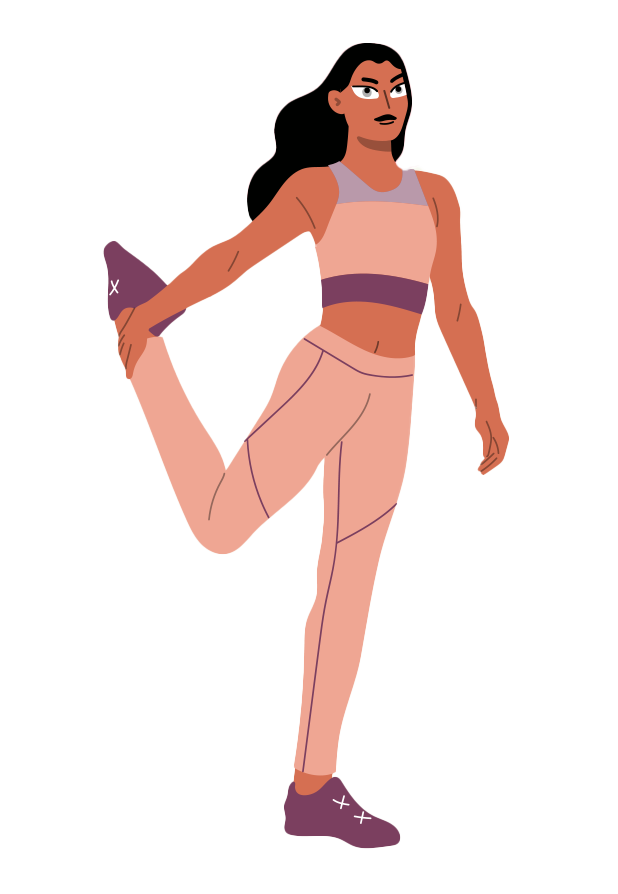
Warm Up & Cooldown – Accessible Text
Info on WHY you should be doing BOTH to prevent injury and make you a better performer!
Warmup and Cooldown
Why you should be doing both to prevent injury and make you a better performer!
Warming Up
Moving your body for 5-10 minutes before your class or lesson helps get oxygen and nutrient-filled blood to your muscles and gets them ready to work!
It also wakes up your brain so you can learn new motions, decreases stiffness or tightness, and improves your breathing.
Warming up should include non-performing art specific movements (in other words avoid scales and ballet barre) and moving through your stretches (not holding them).
Cooling Down
Slower movement/stretching for 5-10 minutes is necessary after class to get your muscles back to their resting state.
This decreases soreness, tightness, and slows down your heart rate and breathing after physical activity.
Lightly marking and visualizing movement as part of a cool down helps with learning those new moves–and this is a great time to work on your flexibility as your muscles are very warm!
Recovery
Taking care of your body and listening to it is important to keep performing, especially if you are feeling more sore than usual, having pain that is lasting, or are experiencing ringing or fullness in the ears, sensitivity to everyday loud sounds, perceiving sounds differently in each ear.
Recovery does not equal resting. It includes cross-training, like Pilates, Yoga, or cardio outside of class, and addressing any areas of limitation—like flexibility or strength—that may keep you from performing your best.
And don’t forget about Nutrition!
Fueling your body so that you have the energy to move is an important piece of the performance puzzle!
Staying nourished and hydrated throughout the day, bringing healthy snacks to class, and not skipping meals will help you learn, move, and feel amazing!
Foods rich in vitamins, minerals, protein, and healthy carbs & fats are key!
Did you know?
Fatigue is the NUMBER 1 risk factor for injury in performers.
Getting enough quality sleep (at least 7-8 hours/night) helps you with schoolwork and performance.
Limiting noise exposure and wearing hearing protection devices may prevent adverse effects during the recovery process.
Conditioning outside of class allows your body to be able to perform ABOVE and BEYOND–keeping you from getting tired in class!
For more info, contact:
Kristen Schuyten, PT, DPT, SCS
[email protected]
Warm up/Cool Down for Stage Combat, Tumbling, Acrobatics
Warm Up: Stage Combat
- Wig Wags x10
- IT Band Stretch x10
- Russian Twists x10
- Lunge with Rotation x10
Warm Up: Tumbling & Acrobatics
- Sit up with overhead arm press x15
- Pilates rolling like a ball x10
- Yoga shoulder stand x10 seconds
- Downdog to updog x5
- St-up jab/cross x10
Cool Down
- Child’s pose 2 ways x3
- Piriformis stretch x2
- IT Band Stretch x10
- 3-way neck stretch x2
- Pec stretches x2
- Sleeper stretch x2
Warm up/ Cool down for Instrumentalists
Pelvis rock x2
Arm circles x10
Arm hugs x10
Knee extensions x10
Seated trunk rotation x3/20 sec each
3-way neck stretch x2/30 sec each
Seated/supine cervical neck retraction x10/5 sec each
Rhomboid stretch x2/30 sec each
Downward doc with chair x3
Seated piriformis stretch x2/30 sec each
Seated hamstring stretch x2/30 sec each
Quick Warmup for Instrumentalists: https://youtu.be/IBQBVYTO7Ok?si=Epvem1M_NrfmTktj
Quick Cooldown for Instrumentalists: https://youtu.be/_ZKqfz0s_hM?si=dzVhNbk7pSzvsePh
Hand Warm Ups for Instrumentalists
Running/marching in place 2.5 mins
Jumping jacks 2.5 mins
Roll shoulders back 5x
Arm circles front to back 5x
Look over shoulder 5 sec. each
Ear over shoulder 5 sec. Each
Bend elbows 5x
Flip palms 5x
Knuckles down/up in fists 5x
Fist down, open hand up 5x
First circles 5x, both directions
Fist to spread fingers 5x
Touch thumb to each fingertip 5x
Widen fingers palms in & out 5x
Thumbs point up, shift hands left, center, then right 5x, tap thumb to palm after each shift
Curl fingers in like a hook 5x
Fingers to thumb like a tabletop 5x
Curl into a fist (no thumb) 5x
Curl all fingers into a fist 5x
Video link: https://www.youtube.com/watch?v=CMQxS5YxFPM&list=PLVy2jdQD7GRzQ2_q6dTb6ojLoh28DEnfa&index=19
Quick Band Warmup
Scan QR codes for follow-along videos. All exercises may be completed without a band.
Warmup – 10 minutes
- Banded Releve Series 10-15x
- Banded Around the World 10x
- Squat Step Outs 10x
- Banded Forearm Glides 10-15x or 10 pushups if without a band
- Triplanar Hop to Single leg series 5x each
Video Link: Quick Band Warm Up
Cooldown 5-10 minutes
- Figure 4 Stretch 5-10 breaths
- Spinal Twist 5-10 breaths
- Forward Bend 5-10 breaths
- Ankle Circles 10-15 each way
- Connect to breath 5-10 breath cycles
Video Link: Simple Cooldown
When to Use Ice, When to Use Heat
Ice vs. heat Treatment
ICE
- Ice calms damaged tissue and slows blood flow to reduce swelling and inflammation.
- Apply ice for no longer than 20 minutes at a time.
- Do NOT apply ice directly on the skin. Wrap ice in a towel or thin cloth.
- Use ice to treat ACUTE injuries, such as sprains, immediately after the injury.
HEAT
- Heat promotes muscle relaxation and alleviates pain by opening blood vessels to increase blood flow.
- Apply heat for no longer than 20 minutes at a time.
- Wait 48-72 hours after an acute injury to use heat.
- Use heat to loosen tight joints and muscles associated with CHRONIC conditions.
Additional information
- Alternate heat and ice for chronic conditions.
- Check skin for damage every 5 minutes (i.e. freezer burn-reddened/blistered skin).
- Do not use heat if you have no feeling in the affected body part.
- Use heat prior to self-massage, followed by movement and end with ice and stretching.
- When in doubt, use ice.
- Wait 1 hour in-between treatments.
Quick, Daily Movement Ideas for Performing Artists
Engaging in consistent movement habits is proven to be beneficial to our body and mind. It aids in circulation, digestion, metabolism, and resistance to illness. Movement breaks can lift our mood and improve concentration.
Daily movement is different from exercise which is usually planned, structured, and repetitive to maintain fitness levels. Rather its goal is to reconnect us with our body’s natural desire to move and stimulate our blood flow and energy levels.
- Stand or take a walk while talking on the phone.
- Set an alarm every 45 minutes to take a brisk walk in the space you are in.
- Sit on an exercise ball as you work.
- Do 10 arm circles on each side.
- Move through three of your favorite yoga poses (e.g. tree pose, child’s pose, mountain pose, etc).
- Do 5 seated twists on each side in your chair.
- Jog in place for 30 seconds to 60 seconds.
For quick movement videos delivered to your inbox weekly, subscribe to the Mind-Body Balance Series.
For more ideas, watch “Take A Movement Break” on the SMTD Wellness YouTube playlist.
Questions? Contact us at [email protected]
Seated Cooldown
Upper Trapezius (Neck)
Mid-Upper Back
Hip Flexors (Thigh)
Hamstrings
Chest/Shoulders
Shoulders/Triceps
Low Back
Glutes
Video link: https://www.youtube.com/watch?v=VPz-ZfvFm9o&list=PLVy2jdQD7GRzQ2_q6dTb6ojLoh28DEnfa&index=7
Instrument Sound Levels by Decibels
Trombone – 85-114
Clarinet – 85-114
Oboe – 95-112
Cello – 85-111
Timpani & Bass Dru – 106
French Horn – 90-106
Piccolo – 90-106
Flute – 92-103
Piano Fortissimo – 94-103
Violin – 82-92
NIOSH RECOMMENDED EXPOSURE LIMIT – 85
Fortissimo Singer – 70
Normal Conversation – 60
Be Proactive to Protect Your Hearing Health
- Notice warning signs: Notice tinnitus (ringing, buzzing, crackling, etc.), feeling like your ears are plugged, hyperacusis (intolerance to everyday loud sounds), or diplacusis (perception of hearing a tone differently in each ear).
- Avoid sound overexposure: Avoid sound overexposure in rehearsals by balancing repertoire practice (alternate loud and soft sections).
- Safe distance: Maintain a safe distance from sources of loud noise.
- Adjust listening levels: Keep MP3 players and phones at safe listening levels at approximately 1/3 volume (85 dB).
- Take breaks: Take breaks during exposure to elevated noise levels (quiet time).
- Use apps: Use an app to raise your awareness of loud sounds (e.g. NIOSH Sound Level Meter app).
- Wear earplugs: Wear musicians’ earplugs where possible (high quality non-custom molds are inexpensive; custom-made earplugs are best but may be more expensive).
- Educate yourself:
Learn about safe decibel levels:
85 dbs – safe for 8 hours
90 db – safe for 2 hours
100 db – safe for 15 minutes
110 db – safe for 2 minutes
Contact us:
For information about hearing screenings and obtaining non-custom mold earplugs, reach out:
Dr. Paola Savvidou, [email protected].
To schedule an appointment with a Michigan Medicine audiologist, please call 734-936-8051 for a time and convenient location.
Vocal Fitness & Wellness BASICS
- Warmup
- Take 7-10 minutes to calibrate your voice before active singing, skill-building exercises and technical voice work. Examples include:
- Gentle lip trills in head register
- Hums in a comfortable speaking range
- Water resistance exercises (see video)
- Cooldown
- Focus more on descending patterns.
- Incorporate the opposite of what you have been doing vocally (e.g. if you have been engaging in chest-dominant voice use, be sure to incorporate light head register cooldown exercises such as lip trills).
- Take Vocal Naps
- Take 15-90 minute voice breaks after active voice use (e.g. rehearsal, performance)
- Complete a vocal cooldown BEFORE beginning a vocal nap.
- Identifying Problems
- Notice early warning signs such as vocal fatigue, loss of higher range, decline in vocal quality, and an inability to sing softly in your higher head register.
- If you notice any of these symptoms and you are not ill, you could be developing a voice problem.
- Simple Voice Check
- Pulse on the word “you” 5 times in your head register at the softest volume you can. If you notice a delayed onset of sound, this can indicate a problem.
- Distributed Practice
- Practice for shorter periods more frequently.
- For example, instead of spending 1.5 hours in a practice room, practicing for 15 minutes 4-5 times during the day is better.
- Cross-Train Your Voice
- Even if you only sing in one vocal style, you should cross-train your entire vocal range.
- For example, if you only sing pop, rock, and R&B, you should still incorporate voice exercises that target your head register and vice versa. This will result in a more balanced voice that is more efficient.
- Vocal Budget
- Think of your voice as having a daily budget. Speaking and singing use up some of this budget. Loud speaking, throat clearing, and yelling all use a significant amount of your daily vocal budget.
- Consider where you can save vocal dollars over the course of the day, week, and month.
Questions?
[email protected]
Content developed by Marci Rosenberg, MS, CCC, SLP
Links to YouTube videos:
Intro to Vocal Health Screenings
Quick Vocal Warm-ups and Cooldowns
How to Maximize Your Earplugs
- Insertion and Removal: Give yourself a few extra minutes prior to and after use to ensure good comfort and fit.
- Storage: Keep your earplugs in a place that is easy to remember, so wearing them is convenient and consistent.
- Adaptation: First use of the earplugs should be in a low-pressure environment, such as at home or during practice (e.g. not during a performance!). Our brains need time to adapt to new (and reduced) sound levels!
- Maintenance: The more regular the cleaning, the better! Wash your earplugs with mild soap and water.
- Your Earplugs: Settings with sound levels at or greater than 85 dBA (use NIOSH Sound Level Meter App on Smartphone) such as rehearsals, concerts, or sporting events.
Use Tech to Protect Your Hearing Health
SOUNDPRINT: This app allows you to measure sound levels to help determine if your listening environment is safe.
NIOSH Sound Level Meter App: Designed to help users make informed decisions regarding their listening environment to promote better health and prevention efforts.
Adjust Volume
Volume Limit for Apple
Settings – Sounds & Haptics – Headphone Safety
Helpful Tips:
- Track headphone notifications in your Apple Health App
- Enable the “Noise” app on your Apple Watch. The device will monitor sound levels and send notifications when it’s too loud.
- This app allows you to measure sound levels to help determine if you listening environment is safe.
- Help promote quiet venues by submitting a sound measurement to help you and others find quiet and moderate spaces to hear and connect with others.
- Apple iOS: https://apps.apple.com/us/app/soundprint-find-a-quiet-place/id971189322
- Google Play: https://play.google.com/store/apps/details?id=com.soundprint&hl=en_US&gl=US
Volume Limit for Android
- Designed to help users make informed decisions regarding their listening environment to promote better health and prevention efforts.
- Apple iOS: https://apps.apple.com/us/app/niosh-slm/id1096545820
Contact Michigan Medicine Audiology: 734-936-8051
Scheduling options:
- Full comprehensive evaluation.
- An appointment with an audiologist to discuss appropriate hearing protection options for your hearing health and musical needs.
- Note: Most insurances will require an order from a primary care physician, or the campus health clinic. Please check with your insurance.
Mental Health Infographics
Performance Anxiety Exercises
- Emergency Focus Cue
Create a personally meaningful emergency focus cue to use when something goes awry on stage. This could be a very general cue that can be used with any performance or it could be specific to a particular one. Periodically repeat this cue to yourself as you practice or rehearse, particularly when you feel your mind start to wander. Write your emergency focus cue here: - Dealing With Distractions
Think about a past or upcoming performance. List five possible distractions which have happened to you before or during a practice or performance, or which could possibly happen in the future. These can include distracting situations, events, or thoughts. For each distraction, write out a strategy for how you can refocus yourself. Plan ahead. For each possible situation, what will be the best action for you to take?- Distractions:
- Strategies:
- Positive Affirmations
Think of an upcoming performance, formal or informal, and write two or three short sentences of affirmation which express what you want to think, feel, or do. Be sure to keep these sentences optimistic, but truthful and realistic, and construct them using first-person present tense. Try to avoid comparative statements in favor of those which foster personal satisfaction. Write your affirmations here:
Tips for Performance Anxiety
- Prepare: Preparation is important. Anxiety will be worse if you are feeling underprepared.
- Move: Move in ways that help you relieve physical tension before a performance (warmups, exercise, jumping jacks).
- Reframe: Reframe anxiousness to positive excitement.
- Beta Blockers: Beta blockers are often used to reduce symptoms of performance anxiety. While they may reduce physical symptoms, the mental and emotional symptoms are still present. As with any type of medication, beta blockers should only be used in consultation with a doctor and with a prescription.
- Nutrition: Consider what you eat and drink prior to a performance. Complex carbohydrates (such as whole grain pasta) are digested more slowly and can stave off hunger during a performance. Caffeine may increase nervousness so you might consider limiting your intake.
- Rehearse: Practice putting yourself in situations where you can practice performing even when you are nervous. The nerves will not go away. What we can do is notice them and be able to play even when we are having those symptoms. Come up with ideas for performing in progressively more stressful situations over time so you can build tolerance.
- Rest: Getting adequate sleep can help us manage stress and manage intense emotions more effectively. In the days leading up to a performance, clear out your schedule so you can be well rested.
Download as PDF
10 Guided Mindfulness Prompts
- Mindfulness helps integrate the mind and body by directing attention to the present moment. It helps us notice patterns in our thoughts and actions, increasing our self-awareness.
- Find a comfortable seated position and choose one of the questions below. Take three deep breaths to allow the upper body to relax and the eyes to close. Reflect on the question for 2-3 minutes while continuing to take deep, mindful breaths. Take three deep breaths and gently reopen your eyes. Notice how you feel.
- What does being calm look like to you?
- What is at the core of your being as the person you are today? How can you strengthen your connection to this inner core?
- When was the last time you did something for the very first time?
- What messages are you giving your inner dialogue? How can you be gentle with yourself today?
- What was something difficult you faced today? How did you handle it?
- What is your current energy level? What is possible for you at this level?
- At this very moment, what do you need the most? How can you start to obtain it within the next five minutes, ten minutes, and thirty minutes?
- Which parts of your body are most affected by stress? What are some experiences that trigger these sensations? How can you approach yourself with kindness?
- Which activities are most engaging to you? Why do you think this is?
- Is there a specific moment you felt particularly present today?
Self Care Infographics
Journal Prompts to Cope with Stress
Write down all the thoughts that are spinning in your head today. Once you’ve written them on paper, give yourself permission to let the worries aside for a while and come back to journaling later on.
- The things that help me the most right now are…
- A few things I can do for self-nourishment are..
- What words can I use to empower myself?
- What are three things that are going well for me now? Make a list of small wins.
Think about an activity, or a hobby you do that makes you feel expansive and lifts your mood. Describe how it makes you feel. Think about ways you can do this activity more often.
Find a comfortable seated position and breathe for a few moments. Notice which parts feel open and relaxed, and which ones feel tense. Write down the physical sensations you noticed. How can you let go of the tension you feel?
Download Prompts as PDF
Self-Care for Illness-Prevention
Self-Care to Prevent Illness
Emily Hyssong, LMSW
Taking Care of Yourself Might Look Like…
- Listening to your body: notice your stress levels, tightness, tiredness, or tension.
- Managing stress levels.
- Saying “no” to extra responsibilities.
- Managing your time well.
- Finding outlets.
- Reaching out for support.
- Asking for help.
Not Taking Care of Yourself Might Look Like…
- Not eating & sleeping regularly.
- Not asking for what you need.
- Not practicing self-compassion.
- Ignoring your limits, over-scheduling, not taking breaks.
- Not setting boundaries with yourself and others.
Who to ask for help:
- People you trust
- CAPS/CAPS SMTD Counselor
- UHS
- Wolverine Wellness
- SMTD Wellness Program
Self-Care through Boundary-Setting
Setting Boundaries as a Form of Self-Care
Emily Hyssong, LMSW
What are Boundaries?
- Guidelines, rules, limits that help you feel safe and comfortable in your relationships.
- They can define the relationship between you and everyone else around you.
- They can be physical, sexual, material, mental, and emotional based on our needs.
- They can be evolving, flexible, and based on context.
- They are all about communicating your needs for healthy interactions.
What does it sound like to communicate your boundaries?
- “I want to do my best work, and won’t be able to take that project on right now.” (work/time boundary)
- “I don’t feel comfortable sharing about that.” (emotional boundary)
- “I don’t want you to use my computer.” (material boundary)
- “I am not open to hugging at this point.” (physical boundary)
Remember..
Healthy boundaries are always determined by YOU and not by others. Not everyone may agree or understand your boundaries, but that doesn’t mean you shouldn’t have them.
“The root of self-care is setting boundaries: it’s saying no to something in order to say yes to your own, emotional, physical, and mental well-being” – Nedra Glover Tawwab
Download as PDF5 Tips for Managing Seasonal Affective Disorder
- Sunlight exposure: Even though the sun may not shine quite as bright in the cooler months, there are other ways to get some sun, such as sun lamps, located in the Music Library Well-being Corner or the Dance Building Personal Room.
- Eat well: Part of feeling good is making sure you are eating a well-balanced diet. Make sure you are eating regularly and drinking enough water every day.
- Get moving: Exercise is scientifically proven to make us feel better mentally! Doing some sort of movement every day, whether it’s going to the gym or dancing in your room, taking a walk, or a few jumping jacks can help put you in a better mood for the day.
- Be kind to yourself: Struggling with depression is not easy in the slightest. It’s essential that we are giving ourselves grace during times that can be hard to manage.
- Talk to Someone: When you feel that you may be holding on to a lot of emotional stress, try talking to someone, whether it be a friend, a parent, a sibling, or even a professional therapist.
For Instructors
Meditation Scripts for Classroom Use
Quick Body Scan
Quick Body Scan
“Welcome! Let’s get started with a quick body scan as we transition to our class/lesson/rehearsal time. Place anything your holding in your hands (e.g. phones, tablets, pencils, instruments, etc.) on your table or on the floor. Lengthen your back and feel both feet on the floor. Let your gaze rest downward, or close your eyes if you are comfortable. Start to notice your breath… the inhalation… the exhalation… Notice your feet on the floor. Feel the weight of your body as it transfers to the ground. With your mind’s eye, travel up one leg, and then the other. Notice any sensations that are coming up.
Perhaps the feeling of your skin on your clothes, your muscles, the temperature around your skin. Shift your attention to your pelvis. Then slowly move up your spine. You might notice its shape, or the way it moves as you breathe. Notice your right shoulder, moving down your right arm all the way to your fingertips. Then the left shoulder, down your left arm down to the fingertips. Bring your attention to the back of your neck, and then your face. Notice the muscles in your face, your tongue, the pressure in your eyes. Move down to your chest.
Notice any movement in the ribs as you breathe. And finally come back to your breath, noticing movements in your belly as you breathe in and out [pause for a moment]. Gently open your eyes if they are closed and take a deeper breath.”
Download as PDFBreathing Meditation
Breathing Meditation
“Welcome everyone! Let’s get started with a couple of breaths as we transition to our class time. Place anything you’re holding in your hands (e.g. phones, tablets, pencils, etc.) on your table or on the floor. Lengthen your back and feel both feet on the floor. Let your gaze rest downward, or close your eyes if you are comfortable. Start to notice your breath… the inhalation… the exhalation… As you breathe allow for a bit more space for the breath to fill your lungs. Allow the breath to be easy and gentle. A couple of more breaths in this way… [wait]
After the next exhale gently open your eyes if they are closed. Now that we have arrived in this moment, let’s continue with…”
Download as PDFMindful Pause
Mindful Pause
“I recognize that everyone has busy days. Let’s take a moment for a mindful pause before moving on to the next item on our agenda. You may close your eyes if you are comfortable, or keep your gaze soft. Focus your attention either on your breath, or an object in the room, or the sounds you are hearing. Stay with what you chose to focus on for a few seconds, simply noticing, without trying to change anything [wait]. Take a deeper breath and gently open your eyes if they are closed.”
Motivational Interviewing Values & Strategies
Strategies for Supportive Conversations –
Motivational Interviewing Values:
- Evocation: Exploring the person’s intrinsic motivation for change and allowing them space to come up with their own solutions.
- Acceptance: Affirming the person’s strengths and ability to make change.
- Partnership: Taking a collaborative approach towards finding solutions and supporting the person’s opinions, even if those are different from your own.
- Compassion: Understanding another person’s perspective without judgment and working towards the best outcome for that person.
Motivational interviewing Strategies:
- Open-ended questions
- Affirmations
- Reflections
- Summaries
Strategies for Supportive Conversations
Key Elements of Support
Strategies for Supportive Conversations – Key Elements of Support
- Body Language
- Maintain a calm demeanor.
- A tall, open posture communicates a willingness to listen.
- Keep a soft gaze and maintain eye contact if the student seems comfortable.
- Sit at an angle as opposed to across from the student.
- Nod to express understanding; remain neutral while the student is talking.
- Language
- As much as possible, listen without talking or reacting.
- “Uh-huh”
- Express empathy.
- “I hear you.”
- “That must be really tough on you.”
- “I’m sorry to hear about what you are going through.
- Avoid using “you” statements. Rephrase those as “I” statements instead.
- Keep the tone of your voice calm no matter what the student says.
- As much as possible, listen without talking or reacting.
Strategies for Supportive Conversations - Written Communication
Strategies for Supportive Conversations
- Written Communication
- Express both empathy and support in your email response.
- If possible, set up an in-person or Zoom meeting, or a phone call to better understand the situation and work together towards a solution.
- Consider offering 1-2 accommodation options, inviting the student to offer a different solution, if they’ve thought of one, or to choose between the ones you provided.
Student of Concern Folder - Dean of Students Office
Student of Concern Folder – Dean of Students Office
What Should I Do?
Every situation and student is unique:
- It’s an emergency: call 911 for situations that require immediate assistance.
- It’s a concern: For a student exhibiting concerning behavior or for a concern for a student’s well-being, contact the Dean of Students Office.
Student Life: Dean of Students
Contact
Phone: 734-764-7420
Email: [email protected]
Campus Location: 3100 Michigan Union
Office Hours: Mon.-Fri. 8:00 AM-5:00 PM
Website: deanofstudents.umich.edu
Who We Serve
Student: One-on-one support, care, and assistance
Student Group(s) or Organization(s): Support, care, and assistance
Faculty & Staff: Advice and consultation
Parents & Families: Information sharing, advice, and consultation
How the Dean of Students Office Can Help
The Dean of Students Office (DOS) works with students, student groups, faculty/staff, and parents/families whenever a critical incident occurs. A critical incident is an emergent need, situation, or life event that is impacting a student and is affecting their academic and personal well-being and success at U-M. DOS provides direct support and assistance to students who experience a critical incident, consults and connects with campus partners to gather more information and coordinate a response to a particular situation, and/or creates connections with campus and community resources that could be most helpful.
Confidentiality & Privacy
Information shared with a Dean of Students Office staff member, either verbally or in writing, will remain private. However, this information does not fall under the same confidentiality/privilege levels of a health care provider, psychotherapist/counselor, or other confidential campus resource. A Dean of Students Office staff member may need to consult with others in order to provide the best possible assistance to the student and have an obligation to report to the university information related to sexual misconduct and certain crimes. Confidential services are available at a variety of offices and are indicated on the resource list below.
WHEN IN DOUBT, REACH OUT.
Understanding a student’s level of distress is helpful when determining the type of response that may be needed. Below are levels of distress and ways you can help a student who is exhibiting concerning behaviors.
Levels of Distress (Information from University of Michigan Counseling & Psychological Services (CAPS)
Mild Distress
Behaviors that do not disrupt others but may indicate something is wrong and assistance could be needed. Behaviors may include:
- Serious grade problems or a change from passing grades to poor performance.
- Excessive absences, especially if the student has previously demonstrated consistent attendance.
- Unusual or markedly changed patterns of interaction (e.g., avoidance of participation, excessive anxiety when called upon, domination of discussions).
- Trouble managing stress successfully (e.g., a depressed, lethargic mood; very rapid speech; swollen, red eyes; marked change in personal dress and hygiene; falling asleep during class).
Moderate Distress
Behaviors that indicate significant emotional distress and/or reluctance or inability to acknowledge a need for help. Behaviors include:
- Repeated requests for special consideration such as deadline extensions, especially if the student appears uncomfortable or highly emotional while
- disclosing the circumstances prompting the request.
- New or repeated behavior that pushes the limits of decorum and that impacts others and/or the immediate environment.
- Unusual or exaggerated emotional responses that are obviously inappropriate to the situation.
Severe Distress
Behaviors that signify an obvious crisis and that necessitate emergency care. Examples include:
- Highly disruptive behavior (e.g. hostility, aggression, violence, etc.).
- Inability to communicate clearly (garbled, slurred speech; unconnected, disjointed, or rambling thoughts).
- Loss of contact with reality (seeing or hearing things which others cannot see or hear; beliefs or actions greatly at odds with reality or probability).
- Inappropriate communications (including threatening letters, e-mail messages, harassment).
Connecting with a Student of Concern
Often a staff or faculty person will be one of the first persons to find out a student is having personal problems that are interfering with their academic success or personal well-being.
How to help a student in mild or moderate distress
- Try to focus on an aspect of the problem that is manageable. Help the person recall constructive methods used in the past to cope; get the person to agree to do something constructive to change things.
- Do not promise not to tell anyone.
- Avoid easy answers such as “Everything will be alright.©
- Be accepting and respectful of what is said. Respect the student’s value systems, even if you don’t agree.
- Trust your insight and reactions. Let others know your concerns.
- Attempt to address the person’s needs and seek appropriate resources.
- Encourage the person to seek help. Refer them to campus resources like CAPS or the Dean of Students Office.
How to help a student experiencing severe distress
- Remain calm.
- Find someone to stay with the student while the appropriate resources are contacted.
- Remember that it is NOT your responsibility to provide the professional help needed for a severely troubled/disruptive student. You need only to make the necessary call and request assistance.
- When a student expresses a direct threat to themselves or others or acts in a bizarre, highly irrational or disruptive way, call the University of Michigan Police Department 734-763-1131for immediate assistance.
Consider
- Has the student exhibited this behavior previously? Is the behavior non-threatening?
- Is there a concern for the student’s general
- well-being? Is the student exhibiting a high level of distress? Is their behavior impacting others?
- Is there an immediate threat to self and others? Have they shared specific or indirect plans of harm to self or others?
Response
- If there is an immediate threat, call 911. If there is a severe concern but it is not an emergency, call the University of Michigan Police Department 734-763-1131.
- Meet with the student to check in and address the student’s behavior. Connect the student with appropriate campus resources as necessary. See back of folder for options.
- When in doubt, refer to the Dean of Students Office (734-764-7420; deanofstudents@umich edu).
If you are worried about a student’s safety:
- In a private setting, voice your concerns to the student and describe the behavior or situation that is worrisome to you.
- If you are concerned the student may be feeling hopeless and is thinking
- about ending their life, ask if they are contemplating suicide. Asking about suicide does not lead the student to think or do more about it. It is important to remember talking about suicide is a warning sign that needs follow up. Seek help from one of the resources on campus for appropriate follow-up with the student.
- Offer yourself as a caring person until professional assistance has been obtained.
- Consult with others in your department/office about your experience.
Contact the Dean of Students Office at 734-764-74 to discuss your concerns and develop a plan for additional follow-up and response. A DOS staff member can be reached via UMPD after regular business hours for emergency situations.
If a student is in crisis after regular business hours:
Dean of Students Office (DOS)
If an urgent situation has occurred for which immediate assistance is needed, you can connect with the Dean of Students Office staff member on call after regular business hours. Contact the University of Michigan Police Department (UMPD) at 734-763-1131 and ask to speak with the DOS staff member on call.
Counseling & Psychological Services (CAPS)
After-Hours Phone Line 734-764- 31 (Press 0)
If you believe a student should connect with a mental health provider immediately, connect them with the CAPS After Hours Phone Line. This service is an extension of CAPS and can assist a caller in any mental health crisis situation. Counselors can assist in accessing CAPS or other campus resources. CAPS is part of University Health & Counseling (UHC).
University of Michigan Police Department (UMPD)
734-763-1131 or 911
If you believe a student may harm themself or others or is in an emergency situation for which immediate contact or assistance is necessary, call UMPD. UMPD can try to locate a student, make sure they are aware of campus and community resources, and transport them to the hospital if necessary.
Sexual Assault Prevention & Awareness Center (SAPAC)
24-hr Crisis Line 734-936-3333
If a student has been impacted by sexual misconduct, you can connect them with SAPAC which provides confidential crisis intervention, information, and referral for survivors and their friends and family members.
Resources
These may be helpful referrals for students you are assisting and supporting.
Counseling & Psychological Services (CAPS) *
Part of University Health & Counseling (UHC). Provides counseling and psychotherapy, preventative and educational programming, consultation, community engagement and outreach, and online resources to promote emotional well-being.
734-764-8312, caps.umich.edu
Concern: Student mental health
Student Accessibility & Accommodation Services (SAAS) / Services for Students with Disabilities (SSD)
Provides academic accommodations and support services, such as assistive technology, academic coaching, scholarships/funding, for students with disabilities.
734-763-3000, ssd.umich.edu
Concern: Student disability access and accommodations: Academics
Equity, Civil Rights, & Title IX (ECRT)
Provides support, resources, and education to promote a safe and non-discriminatory learning, living, and working environment for all members of the university community.
734-763-0235, ecrt.umich.edu
Concern: Reporting discrimination and/or harassment, sexual misconduct
Office of Student Conflict Resolution (OSCR)
Promotes a safe and scholarly community in which students navigate conflict in a peaceful, socially just, and self-reflexive manner through conflict resolution services and restorative justice interventions of Statement violations.
734-936-6308, oscr.umich.edu
Concern: Conflict resolution, Statement of Student Rights & Responsibilities violations
Office of Financial Aid (OFA)
Offers grants, scholarships, loans, and federal work-study funds to eligible entering and continuing students.
734-763-6600, finaid.umich.edu
Concern: Financial insecurity, financial aid eligibility
University Health Service (UHS) *
Part of University Health & Counseling (UHC). Provides integrated, evidence-based, and comprehensive clinical care. Nurse advice is available 24/7.
734-764-8320, uhs.umich.edu
Concern: Physical, Mental, and Sexual Health, Addiction Medicine, Eating and Body Image
Wolverine Wellness *
Campus well-being and health promotion offering well-being coaching, training, consultations, harm reduction resources, and recovery support.
734-763-1320, uhs.umich.edu/wolverine-wellness
Concern: Health and Well-being, Alcohol/Drug Use or Recovery
Office of the Ombuds *
A confidential resource that offers informal dispute resolution services, provides resources and referrals, and helps students consider options available to them.
734-763-3545, ombuds.umich.edu
Concern: Student complaints about the functioning of the university
Sexual Assault Prevention & Awareness Center (SAPAC) *
Provides educational and supportive services for the university related to sexual assault, intimate partner violence, sexual harassment, and stalking.
734-764-7771 (office), 734-936-3333 (24 hour crisis line), sapac.umich.edu
Concern: Survivor support
Well-being Collective
Critical incident response and student support in the Dean of Students Office is connected to the Well-Being Collective, which is a collaborative effort focused on making U-M a better place to live, work, and learn for students, faculty and staff by implementing a system- wide approach to supporting well-being across campus. Additional information about the Well-being Collective, including tools & resources, and how to get involved can be found at this website: wellbeing.umich.edu
* Indicates a confidential resource
Download as PDFQuick Reference Toolkits
Physical Health Toolkit
Nutrition Toolkit
Mental Health & Well-being Toolkit
Physical Health Interactive Toolkit
Physical Health Toolkit: A Resource Guide for Students
SMTD Resources
- Performing Arts Health Clinic and Screenings
Meet with a physical therapist and/or hand specialist to discuss any physical pain or injury, or for a postural assessment. - Hearing Screenings
Free hearing screenings for SMTD students, faculty, and staff, through a partnership with Michigan Audiology and Wayne State University. - Voice Screenings
The Vocal Health Center provides free voice screenings for any SMTD student who has concerns about their voice. - Mind-Body Balance Series
Free range of video/audio and in person classes from a weekly walking group, to self massage, yoga and more. - Wellness Courses for Credit
Intro to Alexander Technique, Wellness for the Performing Artist, Yoga for Performers - Wellness YouTube Playlist
Series of educational videos such as warm ups, cooldowns, stretching routines, and more.
UHS University Health Service
- How to Access Healthcare: https://uhs.umich.edu/appt
Unsure what to do about a health concern? Wondering if you need an appointment? This UHS page can help. - COVID-19 Testing: https://uhs.umich.edu/covid-testing
How and where to get tested. - Sexual Health: https://uhs.umich.edu/sexual-health
- Resources and education for Sexual Health needs
- Nurse Advice Line: https://uhs.umich.edu/advice
Free advice by phone on self-care and deciding where and when to go for health care, if needed. -
Recreational Sports
- Rec Sports Offerings: https://recsports.umich.edu/
Students enrolled in at least one credit have free access to group fitness, personal training, intramural sports and more.
NeuroSport
- Concussions: https://www.uofmhealth.org/conditions-treatments/pediatric-brain-neurological/brain-neurological-conditions/concussion
Important concussion education and care information. - Education: https://concussion.umich.edu/education/
Common concussion symptoms and what to do if concussion is suspected.
Access Toolkit
Nutrition Toolkit: A Resource Guide for Students
UM Nutrition Resources
- Food Resources for UM Students: Contains links to all food and nutrition resources provided by the University, the City of Ann Arbor, Washtenaw County, and Metro-Detroit.
- Maize & Blue Cupboard: Provides food, kitchen equipment, personal and household supplies, and food insecurity support.
- Michigan Dining: Provides information for M-Dining services, meal plans, nutrition and sustainability guidance.
- Nutrition Clinic (UHS): Nutrition services are provided by a Registered Dietitian Nutritionist (RDN) in a positive manner to support well-being. Considering health needs, culture, and lifestyle, the dietitian can assist you with a variety of nutrition-related concerns.
- School of Public Health Nutrition Counseling Center: Includes directions to the several campus and community resources devoted to helping you manage your overall well-being, including your mental and physical health.
- Campus Farm: The Campus Farm at Matthaei Botanical Gardens is a student-driven multi-stakeholder living learning lab for sustainable food systems work built around principles of food grown by students for students that are accessible to all Michigan Students.
- Mindful Eating Journal: This journal helps students reflect and practice mindful eating.
SMTD Resources
- Healthy Snacks: A list of healthy snack combinations that keep your energy up and your body nourished.
- [Video] I Know What Food Is. But What Is Nutrition?
Performing WellCAST episode addressing nutrition myths and keys to a balanced diet.
Recipe Videos
- Celebrate National Chip and Dip Day: Baked Artichoke Dip
- Savory Breakfast on the Go: Mini Omelet Cups
- Bagged Lunches for Grown-Ups: Hearty Tacos Two Ways
Access Toolkit
Mental Health & Wellbeing Toolkit
A Resource Guide for Faculty and Staff to Support Students
SMTD Resources
- Embedded CAPS Counselor
- Wellness Coaching
Amy West, Certified Health and Wellness Coach - SMTD Peer-to-Peer Support Network
Brings together students interested in both giving nonjudgmental support to their peers and receiving support. - Wellness YouTube Playlist
Series of educational talks on topics of interest to the performing artist.
CAPS Counseling and Psychological Services
- Faculty Toolkit: Fostering a Campus Environment Supportive of Student Mental Health
- Faculty And Staff Guide For “Common Scenarios”
Tips and resources to guide you through interactions with students. - Silvercloud: Online, self-guided, interactive mental health resource that provides cognitive behavioral interventions.
- MiTalk:Site includes online screenings for depression and anxiety, skill-building tools for stress management and academic skills, as well as digitally recorded lectures, events, and workshops, and downloadable videos.
Syllabus Resources
- Syllabus Statement For Wellbeing: Show your students you are interested in their wellbeing.
Well-being Collective
- Well-being Toolkit: Interactive, customizable and adaptable tools that promote a holistic and inclusive understanding of well-being.
- Continuum of Care: An array of public health informed mental health
Center for Research on Learning and Teaching
- Supporting Students Facing Mental Health Challenges
Clear data and steps to proactively support student well-being. - “HELP: MY STUDENTS ARE OVERWHELMED, AND SO AM I!”
Blog with context about our current times and how to navigate it
Eisenberg Family Depression Center
- Depression Toolkit: Information, tools, support, and resources to guide you through your mental health journey.
- College Mental Health Resources: Connecting students with initiatives and resources tailored to their unique needs.
- Athletes Connected: Find information specific to student-athletes around enhancing mental health, performance, and help-seeking.
- Campus Mind Works: Website created to support the mental health of UM students. Site provides quick access to support services through a searchable database.
Dean of Students
- Resources To Support Students:Central place for students, parents, faculty, and staff to seek assistance in navigating the complex issues of campus life.
Wolverine Wellness
- Collegiate Recovery Program: Provides holistic, tailored support to Michigan students who are in recovery from alcohol or other drug problems.
- Wellness Coaching: Optimizing wellness for student success.
- Wellbeing Academy: Provides training for faculty, staff, and students in support of student well-being.
University Health Service
- Appointments: Provide a variety of services for health and well being.
- Nurse Advice Line: Free advice by phone on self-care and deciding where and when to go for health care, if needed.
Maize and Blue Cupboard
- Maize And Blue Cupboard:Offer food, kitchen and household supplies, and support for students facing food insecurity.
Spectrum Center
- Spectrum Center: Campus resource center dedicated to serving and supporting members of the University of Michigan’s LGBTQIA2S+ communities.
Services for Students with Disabilities
- Services For Students With Disabilities: Assist students, faculty, instructors, and staff in requesting, approving, and implementing disability-related accommodations.
Multi-Ethnic Student Affairs
- Multi-Ethnic Student Affairs: Provides support and programming through celebrations, educational offerings, and building social capital through the lens of race and ethnicity.
Mental Health & Crisis Resources
- UM Psychiatric Emergency Services, 734-936-5900 (24 hours)
- Counseling and Psychological Services, 733-764-8312 (business hours & after hours)
- Washtenaw County CARES Crisis Services, 734-544-3050 (24 hours)
- Suicide & Crisis Lifeline, 988
- The Trevor Project, 1-866-488-7386
- National Domestic Violence Hotline, 1-800-799-7233
- University of Michigan Addiction Treatment Services, 734-764-0231
- UM Comprehensive Eating Disorders Program, 734-232-7531
- Sexual Assault Prevention and Awareness Center, 734-936-3333 (24 hours)
Faculty Mental Health Support
- Faculty And Staff Counseling And Consultation Office
- MHealthy, 734-647-7888
Additional Educational Resources
- Teaching Faculty To Support Student Mental Health
- Meditation Script For Classroom Use
- Instructors Part On Supporting Students Mental Health
- 4 Ways Faculty Can Be Allies For Students Mental Health
- University Of Wisconsin: Communicating With Students
Physical Health Interactive Toolkit
A Resource Guide for Students
- Nutrition Videos:
Optimal Performance Nutrition: Hydration
Optimal Performance Nutrition: What to Eat Before and During Performance - Warmup and Cooldown Videos:
Quick Warmup for Instrumentalists
Quick Cooldown for Instrumentalists
Warmup for Stage Combat
Warmup for Tumbling/Acrobatic Work
Cooldown for Stage Combat
Performing WellCAST: Simple Seated Cooldown
Performing WellCAST: Take a Movement Break - 15-Minute Yoga Breaks: Full BodySelf Massage Videos:
Performing WellCAST: Self-Massage: Foot and Calf
Performing WellCAST: Self-Massage: Neck, Upper Shoulders and ChestSelf Care: Injury Prevention Basics
Injury Prevention BASICS
- Warmup and Cooldown: Take 10 minutes to warmup and cooldown before and after rehearsal and practice.
- Alignment: Check your physical alignment and ensure you are returning to neutral frequently.
- Take Breaks: Take a 5 minute break for every 30 minutes of practice to stretch, hydrate, and take a mental break.
- Mindful Repetition: Have a specific goal in mind of what you want to accomplish each time you repeat.
- Take Microbreaks: Take micro-breaks often to notice and release tension (2-3 deep breaths and one stretch).
- Cross-train: Cross-train with your favorite type of exercise followed by low-impact cardiovascular training, strengthening, and stretching.
- Early Intervention: Address injuries early (talk to your healthcare provider, connect with the SMTD Wellness Program, or MedSport for support).
- Actively prevent injury: Consider participating in any of the Mind-Body Balance Series sessions or the Performing Arts Health Clinic offered by the SMTD Wellness Program.
Questions? Contact us at [email protected]
When to Use Ice, When to Use Heat
Ice vs. Heat Treatment
ICE
- Ice calms damaged tissue and slows blood flow to reduce swelling and inflammation.
- Apply ice for no longer than 20 minutes at a time.
- Do NOT apply ice directly on the skin. Wrap ice in a towel or thin cloth.
- Use ice to treat ACUTE injuries, such as sprains, immediately after the injury.
HEAT
- Heat promotes muscle relaxation and alleviates pain by opening blood vessels to increase blood flow.
- Apply heat for no longer than 20 minutes at a time.
- Wait 48-72 hours after an acute injury to use heat.
- Use heat to loosen tight joints and muscles associated with CHRONIC conditions.
Additional information
- Alternate heat and ice for chronic conditions.
- Check skin for damage every 5 minutes (i.e. freezer burn-reddened/blistered skin).
- Do not use heat if you have no feeling in the affected body part.
- Use heat prior to self-massage, followed by movement and end with ice and stretching.
- When in doubt, use ice.
- Wait 1 hour in-between treatments.
Take a Microbreak
30-second breaks can recharge and refocus your practice/rehearsal. Here are a few ideas of what to do:
- Notice and release tension in your body.
- Take three slow breaths.
- Gently re-align your body on your feet, chair, or bench.
- Open your arms wide for a chest opener.
- Tilt your head from side to side.
- Curve and extend your spine a few times.
- Take a few sips of water
- Close your eyes and focus on your breath.
- Massage any spots that feel tight.
Nutrition
Easy Snacks to Fuel Your Body & Brain
Sherry Lin, MFA, RDN
- Apple + Cheese Cubes
- Apricots + Cashews
- Baby Carrots + Hummus
- Banana + Almond Butter
- Berries + Greek Yogurt
- Celery + Peanut Butter
- Crackers + Tuna
- Dried Mangoes + Pistachios
- Grapes + Mozzarella Stick
- Avocado + Hard-boiled egg
Pro Tips:
- Plan your snacks ahead
- Portion out 1-2 servings
- Pair 1 Carb + 1 Protein or Fat
Warmup and Cooldown
Warmups for Your Schedule
Warmup Basics
- Minimum 10 minutes of active warm up
- Focus on active cardio and dynamic stretching
- Dynamic stretching = move in/out of the stretch (max. hold 3-5 seconds) as opposed to holding for increased time
Where?
- Outdoors
- Hallway on the way to class
- Stairs (great for cardio!)
Exercises:
Holding onto wall/leg swings
Heel walks/Toe walks
Shoulder Circles
Toy Soldiers
ITB Walking
Lunge w/ RotationQuick Warmup for Instrumentalists Video
Whole Body Warm-up for Performers VideoBreak Basics
Take Breaks
Studying for an exam? Writing a paper that is due by midnight? Practicing or rehearsing for several hours?
Set a timer to take a break at LEAST once an hour for 5-10 minutes to get your body moving and reduce any tension or pain.Where?
- Desk
- Residence hall
- Study lounge
- Practice room/rehearsal space
Exercises
- Downdog at desk
- Seated hip flexor stretch
- Seated twist
- Seated cat/cow
- Pelvic tilt
- 3-way neck stretch
Quick Cooldown for Instrumentalists Video
Whole Body Stretching for Performers VideoCooldown Basics
Cool down
- Minimum 5 minutes of cooldown
- Focus on static or dynamic stretching
- Static stretching = hold the stretch for at least 15-20 seconds
Where?
- The class you are going to after your movement activity
- Student lounge or any seating area
Exercises
- Upper Trapezius (Neck)
- Mid-Upper Back
- Hip Flexors (Thigh)
- Hamstrings
- Chest/Shoulders
- Shoulders/Trapezius
- Low Back
- Glutes
Video links:
Quick Cooldown for Instrumentalists Video
Whole Body Stretching for Performers VideoWarmup/Cooldown for Instrumentalists
Exercises
- Pelvis rock x2
- Arm circles x10
- Arm hugs x10
- Knee extensions x10
- Seated trunk rotation x3/20 sec each
- 3-way neck stretch x2/30 sec each
- Seated/supine cervical neck retraction x10/5 sec each
- Rhomboid stretch x2/30 sec each
- Downward doc with chair x3
- Seated piriformis stretch x2/30 sec each
- Seated hamstring stretch x2/30 sec each
Quick Warmup for Instrumentalists Video
Quick Cooldown for Instrumentalists VideoHand Warmups for Instrumentalists
Exercises
- Running/marching in place 2.5 mins
- Jumping jacks 2.5 mins
- Roll shoulders back 5x
- Arm circles front to back 5x
- Look over shoulder 5 sec. each
- Ear over shoulder 5 sec. Each
- Bend elbows 5x
- Flip palms 5x
- Knuckles down/up in fists 5x
- Fist down, open hand up 5x
- First circles 5x, both directions
- Fist to spread fingers 5x
- Touch thumb to each fingertip 5x
- Widen fingers palms in & out 5x
- Thumbs point up, shift hands left, center, then right 5x, tap thumb to palm after each shift
- Curl fingers in like a hook 5x
- Fingers to thumb like a tabletop 5x
- Curl into a fist (no thumb) 5x
- Curl all fingers into a fist 5x
Hand Warmups Video
Hearing Health
Be Proactive to Protect Your Hearing Health
- Notice warning signs: Notice tinnitus (ringing, buzzing, crackling, etc.), feeling like your ears are plugged, hyperacusis (intolerance to everyday loud sounds), or diplacusis (perception of hearing a tone differently in each ear).
- Avoid sound overexposure: Avoid sound overexposure in rehearsals by balancing repertoire practice (alternate loud and soft sections).
- Safe distance: Maintain a safe distance from sources of loud noise.
- Adjust listening levels: Keep MP3 players and phones at safe listening levels at approximately 1/3 volume (85 dB).
- Take breaks: Take breaks during exposure to elevated noise levels (quiet time).
- Use apps: Use an app to raise your awareness of loud sounds (e.g. NIOSH Sound Level Meter app).
- Wear earplugs: Wear musicians’ earplugs where possible (high quality non-custom molds are inexpensive; custom-made earplugs are best but may be more expensive).
- Educate yourself:
Learn about safe decibel levels:
85 dbs – safe for 8 hours
90 db – safe for 2 hours
100 db – safe for 15 minutes
110 db – safe for 2 minutes
Contact us:
For information about hearing screenings and obtaining non-custom mold earplugs, reach out:
Dr. Paola Savvidou, [email protected].To schedule an appointment with a Michigan Medicine audiologist, please call 734-936-8051 for a time and convenient location.

